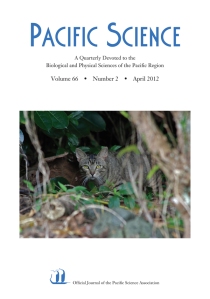
In Appreciation of Professor Dieter Mueller-Dombois
Peter Vitousek and Donald Drake, 117-118
Plant Introductions: Historical Sketches
Michael Kiehn, 119-125
Plant species, their parts, and derivatives have been transferred by humans since the beginning of history: unintentionally (e.g., with propagules adhering to clothes) or intentionally (e.g., when species or parts of them were used for food or as sources of tools). Numerous plant transfers resulted in species becoming permanently naturalized in new areas, in some cases with extremely negative effects for the region to which they were brought. However, transfers also often proved neutral or even beneficial. This article does not intend to give a comprehensive survey of the history and the consequences of plant transfers in space and time but presents and discusses illustrative examples of plant movements by people. Special emphasis is given to effects on islands and to historical, political, and economic aspects of long-distance plant trade in the Old World often little known by botanists.
The Challenge of Retarding Erosion of Island Biodiversity through Phytosanitary Measures: An Update on the Case of Puccinia psidii
in Hawai‘i
Lloyd L. Loope and Janice Y. Uchida, 127-139
Most rust fungi are highly host specific, but Puccina psidii has an extremely broad host range within Myrtaceae and gained notoriety with a host jump in its native Brazil from common guava (Psidium guajava) to commercial Eucalyptus plantations. When detected in Hawai‘i in April 2005, the first invasion outside the neotropics/subtropics, there was immediate concern for ‘ōhi‘a (Metrosideros polymorpha). ‘Ōhi‘a composes 80% of native forest statewide, providing stable watersheds and habitat for most Hawaiian forest birds and plants. Within months, rust spores spread statewide on wind currents, but ‘ōhi‘a was found to be only a minor host, showing very light damage. The primary host was nonnative rose apple (Syzygium jambos), severely affected at a landscape scale, but the epiphytotic subsided as rose apple was largely defoliated or killed within several years. The limited and stable host range in Hawai‘i (versus elsewhere) led the local conservation community to explore possibilities for excluding new genetic strains of P. psidii. Although national/international phytosanitary standards require strong scientific justification for regulations involving an infraspecific taxonomic level, hopes were buoyed when genetic studies showed no apparent genetic variation/evolution in Hawai‘i’s rust strain. A sophisticated genetic study of P. psidii in its home range is near completion; genetic variation is substantial, and host species strongly influences rust population structure. To prevent introduction of new strains, the Hawai‘i Department of Agriculture is moving ahead with establishing stringent measures that restrict entry of Myrtaceae into Hawai‘i. Meanwhile, P. psidii poses a major threat to Myrtaceae biodiversity worldwide.
Introduced Canopy Tree Species Effect on the Soil Microbial Community in a Montane Tropical Forest
Hannah B. Lynch, Kimberly Y. Epps, Tadashi Fukami, and Peter M. Vitousek, 141-150
Within a single site in the Kohala Forest Reserve, Hawai‘i, we examined composition and diversity of soil microbial communities under four introduced (Cryptomeria japonica, Casuarina equisetifolia, Araucaria columnaris, and Eucalyptus sp.) and one native (Metrosideros polymorpha) canopy tree species, as well as pasture. Terminal restriction fragment length polymorphism (T-RFLP) analysis of soil bacteria, fungi, and archaea indicated that soil under the native M. polymorpha had the highest richness and greatest number of unique terminal restriction fragments, whereas soil under Eucalyptus and in pasture sites had the lowest richness. The soil microbial community differed significantly between Eucalyptus and M. polymorpha but not between the other three introduced species and M. polymorpha. The Eucalyptus microbial community was more similar to that of an adjacent deforested pasture site than to those of other forested stands. Soil pH was the environmental variable that best correlated with the ariation in soil microbial community composition between tree species.
Beta Diversity of Tree Species along Soil-P Gradients in Tropical Montane Rain Forests of Contrasting Species Pools: Does Biodiversity Matter in Stabilizing Forest Ecosystems?
Kanehiro Kitayama, 151-160
This study concerns relationships between gamma diversity and beta diversity (species turnover) along a resource gradient. Model sites are the Hawaiian Islands, where the regional floristic species pool of tropical rain forests is much impoverished compared with Borneo, where the regional species pool is two orders of magnitude greater than in Hawai‘i. I examined the relationship between changes in percentage floristic similarity (PS) and changes in the soil P pool among pairs of plots located in these two regions. PS sharply decreased with increasing difference of soil P pool in Borneo (Mount Kinabalu), whereas PS did not significantly change with increasing difference of soil P pool in Hawai‘i. I suggest that a greater number of tree species that have high P-use efficiencies occur in Borneo due to its high gamma diversity. Stronger competitive exclusion because of the high gamma diversity will lead to displacements by species of progressively greater P-use efficiencies along a soil P gradient. Consequently, niche divisions along the soil P gradient will be formed, causing a greater beta diversity in Borneo. By contrast, a single species, Metrosideros polymorpha, monodominates the entire soil P gradient in Hawai‘i, leading to nonexistence of beta diversity along the soil P gradient. There are important implications of beta diversity for ecosystem maintenance. I suggest that a greater beta diversity can maintain forest biomass and productivity against soil P decline by providing more P-use efficient species along the gradient.
The Ahupua‘a of Puanui: A Resource for Understanding Hawaiian Rain-Fed Agriculture
Aurora K. Kagawa and Peter M. Vitousek, 161-172
Intensive rain-fed agricultural systems represented the foundation of the agricultural economies of the island of Hawai‘i and parts of Maui in the centuries before European contact. These systems largely were abandoned in the nineteenth century, and our understanding of how they functioned as productive systems is sparse. We established three experimental gardens within the ahupua‘a (traditional Hawaiian land division) of Puanui, in the Leeward Kohala Field System, where we have measured climate and soil properties and planted several Polynesian crops. We obtained relatively large yields of ‘uala (sweet potato, Ipomoea batatas) (from 1 to 4 kg of tubers per m2) from spring and summer plantings in two wetter, higher-elevation gardens; growth was slow there in the winter. In a drier, lower-elevation garden, only winter plantings provided reasonable yields (0.6 kg per m2). We suggest that Hawaiian farmers cultivated a winter crop of ‘uala in the lower, warmer, drier portion of the field system and grew spring-summer crops in the upper, wetter portion of the system. Ahupua‘a-level management in rain-fed agricultural systems could thus have functioned to integrate environmental variability and sustain yields through the year.
Biology and Impacts of Pacific Island Invasive Species. 7. The Domestic Cat (Felis catus)
David Cameron Duffy and Paula Capece, 173-212
This article reviews the biology, ecological effects, and management of the domestic cat (Felis catus) in the Pacific basin. The cat is one of the most controversial invasive species in the Pacific region because of its complex relations with humans. At one extreme, well-fed domestic house pets are allowed outdoors where they may hunt native animals; at the other, unsocialized feral cats have replaced native predators as apex predators or occupy a new niche on oceanic islands, where they have devastated native faunas. In the middle are stray cats that are still socialized around humans. Feral and stray cats can be reservoirs of diseases that infect free-roaming domestic cats, humans, and wildlife. Given these problems, the best response would be to keep domestic cats indoors, restrict cat breeding, and remove feral populations. However, most Pacific basin societies have failed to reach a consensus on the cat problem, so solutions are ad hoc, often lacking in any scientific basis, and reflect our conflicting views. Compromise management might best fall into three broad classes: (1) eradication of cats should be confined to islands and other areas of high native biodiversity where reintroduction can be prevented; (2) in a landscape of low or moderate biological value, efforts should be made to educate the public to reduce the impact of their cats on remaining wildlife, while excluding cats from “islands” of elevated biodiversity values or human sensitivity; (3) in drastically simplified urban ecosystems, management perhaps should occur only in response to local complaints.
Mikania micrantha Kunth (Asteraceae) (Mile-a-Minute): Its Distribution and Physical and Socioeconomic Impacts in Papua New Guinea
M. D. Day, A. Kawi, K. Kurika, C. F. Dewhurst, S. Waisale, J. Saul-Maora, J. Fidelis, J. Bokosou, J. Moxon, W. Orapa, K. A. D. Senaratne, 213-223
Mikania micrantha or mile-a-minute is regarded as a major invasive weed in Papua New Guinea (PNG) and is now the target of a biological control program. As part of the program, distribution and physical and socioeconomic impacts of M. micrantha were studied to obtain baseline data and to assist with field release of biological control agents. Through public awareness campaigns and dedicated surveys, M. micrantha has been reported in all 15 lowland provinces. It is particularly widespread in East New Britain, as well as in West New Britain and New Ireland. A CLIMEX model suggests that M. micrantha has the potential to continue to spread throughout all lowland areas in PNG. The weed was found in a wide range of land uses, impacting on plantations and food gardens and smothering papaya, young cocoa, banana, taro, young oil palms, and ornamental plants. In socioeconomic surveys, M. micrantha was found to have severe impacts on crop production and income generated through reduced yields and high weeding costs, particularly in subsistence mixed cropping systems. About 89% of all respondents had M. micrantha on their land, and 71% of respondents had to weed monthly. Approximately 96% of respondents in subsistence mixed cropping systems used only physical means of control compared with 68% of respondents in other farming systems. About 45% of all respondents estimated that M. micrantha causes yield losses in excess of 30%. These studies suggest that there would be substantial benefits to landholders if biological control of M. micrantha were to be successful.
Lizards of Tonga with Description of a New Tongan Treeskink (Squamata: Scincidae: Emoia samoensis Group)
George R. Zug, Ivan Ineich, Gregory Pregill, and Alison M. Hamilton, 225-237
The present-day vertebrate fauna of Tonga contains 17 species of lizards from three families: Gekkonidae, Iguanidae, and Scincidae. Are any of these lizard species members of a fauna before humans arrived? This question is examined and partially resolved. Endemic taxa, such as Lepidodactylus euaensis, Emoia adspersa, and E. tongana, are likely inhabitants whose ancestors arrived, before the arrival of humans, via waif dispersal and subsequently differentiated in isolation. Recognition of these species is essential to interpret correctly the evolutionary history of the Tongan herpetofauna. The largest surviving Tongan skink previously has been identified incorrectly as a population of the Fijian Emoia trossula lineage. It is not and, herein, is differentiated from Emoia trossula and other central Pacific members of the Emoia samoensis species group and subgroup. Emoia mokolahi Zug, Ineich, Pregill & Hamilton, n. sp., differs from its sister taxa in the Emoia samoensis species subgroup by body size, dorsal and digital scalation, and coloration.
A New Member of the Bavayia cyclura Species Group (Reptilia: Squamata: Diplodactylidae) from the Southern Ranges of New Caledonia
Aaron M. Bauer, Ross A. Sadlier, Todd R. Jackman, and Glenn Shea, 239-247
A new species of diplodactylid gecko, Bavayia nubila Bauer, Sadlier, Jackman & Shea, n. sp., is described from forests at two sites in the drainage of the Tontouta Valley in the ultramafic ranges of southeastern New Caledonia. The new gecko is the sister species of the much smaller Bavayia goroensis; both species are basal within the B. cyclura clade. The area from which the species is recorded so far is the focus of extensive nickel mining operations, and because of its restricted distribution and the potential threats posed by mining in the region, it is here regarded as Endangered under IUCN red list criteria.
Association Affairs
249




